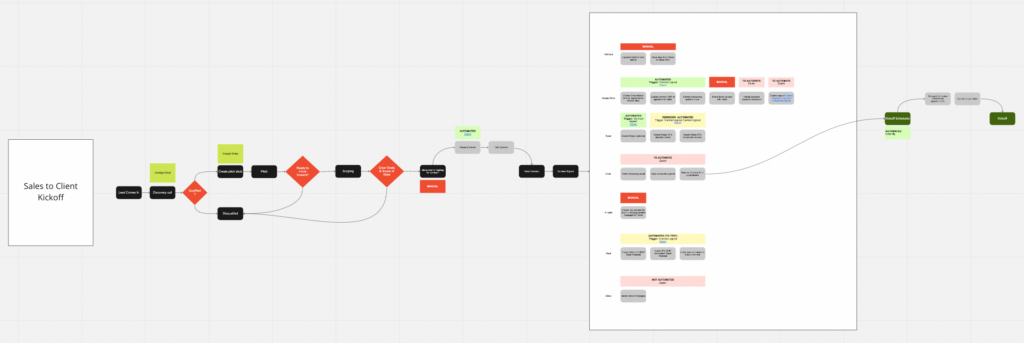
How do you work on a business versus in it?
When I started Omniscient Digital with Alex, we did everything: Sales, content strategy development, content deliverables, project management, client consulting calls, bookkeeping, and more.
After reading the eMyth, we learned that a trap small business owners and startups run into is trying to be owner, manager, and employee at the same time. Successful businesses are built when the founder or owner can extract themselves from the day-to-day and allow the business the scale.
We knew the ideal state is to work on the business vs in it. We had to remove ourselves from the day-to-day minutiae if we wanted to grow to the size and revenue we wanted.
Working on the business vs working in the business
Let’s make sure we’re thinking about “working in” vs “working on” the business in the same way. Here are some examples:
| Working in the business | Working on the business |
|---|---|
| Client consulting calls | Planning |
| Content creation | Process automation |
| Strategy development | Education |
| Marketing | Setting goals |
| Sales | Financial strategy |
| Invoicing clients | Hiring and recruiting |
| Paying invoices | Develop new products/services |
| Responding to clients in Slack | Business strategy |
We built the business on the side to start, working day jobs as we validated whether we could make money. That meant we had a limited amount of time to spend on the business each day, which forced us to remove ourselves from the day-to-day sooner.
Ironically, building a side business with limited time was the key to getting over the initial hump of delegating. If we had all the time in the world, it would’ve been a “rational decision” to do all the work ourselves and make more margins.
But we had a key principle for the business: “This should be fun.”
Off the bat, we knew it would be hard work but we agreed we didn’t want the business to cause unhealthy stress and require us to work crazy hours. It would be difficult to avoid the long hours if we did all the work.
Fortunately, as of this writing, we’re going into the 4th year of the business and we’ve jumped in full-time. We’ve built a business that doesn’t rely us to be involved in every aspect of the day-to-day and we have a solid team that continues to grow.
While we’re still involved in the day-to-day, we spend more time building the business compared to other business owners I’ve met.
Here’s how we did that.
1. Document processes.
This was something we built into the business early on. Actions that we complete more than 3 times are documented. We could do a better job of referencing and updating these documents, but it’s helpful that we have a huge repository of documentation.
Here’s an example of some workflows we’ve documented:

I’ll be honest, writing documentation on how we do things isn’t the most fun activity, but we’re working with the long game in mind. This annoying task now will save us time in the future.
2. Hire sooner rather than later.
The first hire is often the toughest because you don’t know exactly what that person should do or what the role should look like. But once you get over that hump, you’ll be one step closer to moving things off your plate.
Our goal was to avoid getting stuck doing everything. It’s tough to get out of that habit because once you’re in it, you’ll have a hard time making time to work on the business. It’s a vicious cycle.
Don’t get stuck doing all the work or else you’ll get used to it.
Since we built the business part-time as a side hustle, we had limited time to spend on the business. This was a forcing function to hire contractors and learn delegate to and trust others.
This does mean you’ll have lower net income (profit) margins because you’ll be paying someone to help do the work, but you’re also freeing up your time to work on the business while making sure the work is also getting done. That’s the tradeoff.
For you, that could mean time blocking yourself for tasks and for working on the business.
For example, allow yourself to work in the business four of the five days of the workweek and spend the remaining day working on the business, building out processes, recruiting, and hiring.
3. Trust the team.
What’s the point of hiring a team if you end up micromanaging their tasks and projects? Give feedback and help the team improve, but don’t do the work for them.
Doing the work for them might solve the short-term challenge of getting the work done, but in the long-term, it disempowers team members.
This was, and sometimes still is, the hardest part of entrepreneurship and leadership for me and many other business owners.
We’re so used to doing the work. It’s what we’re good at. It’s what we’ve built our careers (and even identities) on. But we’ll need to let go of that to allow the business to flourish.
Set the goals and success metrics, keep your team accountable, and give them the space to do great work.
Two great books that helped with this mindset shift are The eMyth Revisited by Michael Gerber and Who Not How by Dan Sullivan.
4. Automate administrative tasks.
Any and all administrative tasks are scrutinized. These tasks are often just busywork that makes us feel productive but isn’t actually impactful for the business.
The framework of $10 vs $10,000 tasks from Eric Siu at Leveling Up helps. It buckets tasks into 4 categories:
- $10 tasks
- $100 tasks
- $1,000 tasks
- $10,000 tasks
This framework isn’t meant to devalue anyone whose job focuses on $10 tasks. The “value” of the tasks refers to the leverage that the task provides and the long-term value that task creates.
The $10 tasks, like data entry, have no leverage while the $10,000 tasks, like figuring out pricing and packaging, have high leverage. However, those $10 tasks are typically things that just need to get done, like bookkeeping.
I spent one week writing down all the things I did including data entry, document management, sales calls, client calls, etc. Then I categorized each task into one of the 4 value buckets.
I realized that most of the things I did were $10 and $100 tasks. They needed to be done but were low leverage. I decided that if I wanted to grow the business, my time was better spent on high-leverage tasks than data entry and admin.
To learn more about focusing on $10k work, check out Khe Hy’s $10K Institute.
The goal is to instill this into each team member’s way of working. Whenever we do a repetitive or monotonous task multiple times, the first question should always be, “Can this be automated?”
A helpful exercise is to map out a business process down to the very specific steps to figure out what you can automate.
Here’s an example of mapping out the process from initial sales discovery call to client kickoff:

Here are some tasks we’ve automated:
- Create new agreement in PandaDoc and filling out prospect information.
- Create new client profile in Stripe.
- Creating client folders in Google Drive and uploading signed contracts.
- Creating content briefs, which really means copy-pasting information from a spreadsheet into a Google Doc.
These automations help us optimize our time and these processes will undergo further optimization as we discover more things to automate.
There are a lot of apps you could use to set up these types of automations. Our tool of choice is Zapier, which if you’ve used it before, is prone to errors. Sometimes data isn’t copied over correctly. So some automations add a “check” step.
For example, when a new customer profile is created in Stripe, a task is also created for me to review the profile to make sure it’s all correct.
That way 90% of it is automated and I just need to do the last 10% that requires a human check (for now).
What about the tasks that can’t be automated? You can hire an employee or use the workflow documentation you have to outsource it to an overseas contractor. Outsourcing is a great option for getting these tasks done and scaling. To keep your team motivated during this transition, consider implementing employee rewards and recognition programs that celebrate their contributions and encourage engagement with the new processes.
5. Theme your days.
I’ve given each day of the week a specific focus. This has helped me make I set aside time for each part of the business, even if some of those days are spent working in the business.
Here’s how my days are currently themed:
- Mondays: Meetings, admin
- Tuesdays: Sales, recruiting
- Wednesdays: Marketing
- Thursdays: Sales, podcast recording
- Fridays: Reflection, learning, strategy
This might change as things get moved off my place or priorities shift, but it makes sure that I dedicate time for the parts of the business I’m accountable for.
6. Create a layered system of accountability.
I’m fortunate that I get to build with smart people who keep me accountable. We meet every week to discuss progress and challenges and commit to strategic projects.
I also joined Entrepreneurs’ Organization Accelerator to have an external accountability system. The group is made up of business owners at around the same stage so we can learn from each other and keep each other accountable. Since we aren’t involved in each others’ businesses, we can stay high level and focusing on what we’re doing to work on the business.
It’s a different dynamic and meeting cadence as well. I meet with my business partners, Alex and Allie, for at least a weekly sync about the day-to-day operations and strategy. On the other hand, I see folks from EO Accelerator once a quarter.
The other layer of accountability outside of my team and other business owners is my partner. If I talk about challenges I’m having with the business and a month later still talking about those challenges, she’ll point that out. That simple comment keeps me accountable to make progress.
While we don’t have a formal business coach or mentor, we have peers and acquaintances who are also business owners who we share learnings with and learn from. In this way, we continue to coach and support each other.
By taking these steps to remove yourself from the day-to-day, you can zoom out and focus on the big picture of your business. You can spend more time on strategic planning, product development, pricing strategy, and competitive intelligence – tasks that will help you grow and scale.


